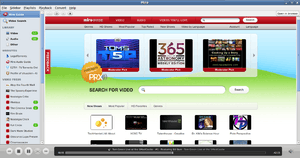Miro (software)
|
| |
|
Miro 3.5 running on Ubuntu, showing the Miro guide in the main window while playing a podcast. | |
| Developer(s) | Participatory Culture Foundation |
|---|---|
| Initial release | 21 February 2006 (0.8.0-rc4 = earliest known) |
| Stable release | 6.0 (April 16, 2013) [±][1] |
| Development status | Inactive |
| Written in | Python using GTK |
| Operating system | Windows, macOS, Linux |
| Size |
|
| Available in | 40 languages[2] |
| Type |
Media player Internet television RSS+BitTorrent |
| License | GPL-2.0+ |
| Website |
getmiro |
Miro (formerly named Democracy Player or DTV)[3] is an audio, video player and Internet television application developed by the Participatory Culture Foundation. It runs on Microsoft Windows, macOS, FreeBSD and Linux and supports most known video file formats. It offers both audio and video, some in HD quality.
Miro would appear to have been abandoned, the last version (6.0) was released in 2013 and is no longer functioning correctly because of changes to the YouTube API.
Miro is free software, released under the terms of the GNU General Public License.[4]
Features
Miro can automatically download videos from RSS-based "channels", manage them and play them. The application is designed to mesh with other Participatory Culture Foundation (PCF) products such as Video Bomb, a social tagging video website, and the Channel Channel, a TV guide for Internet television.
Miro integrates an RSS news aggregator and podcatcher, a BitTorrent client (based on libtorrent), and a media player (VLC media player under Windows, QuickTime under macOS, and xine media player or GStreamer under Linux and FreeBSD). Since 2.0, Miro supports the adding of website bookmarks under the "Sites" category; by default, ClearBits.net is preloaded in Miro as a bookmark.
Examples of supported video files are QuickTime, Windows Media Video (WMV), MPEG, Audio Video Interleave (AVI), XVID as a video player. It also supports RSS BitTorrent. When a new video is available, the program will notify and download if possible.
The Miro Video Converter converts video formats.[5] It is based on FFmpeg with profiles for the Theora (.ogv), .mp4, and WebM video formats supported by various devices.[6]
A developer of Miro wrote that the Windows installer installs proprietary commercial software such as browser add-ons, also known as crapware,[7] stating "This is one of the primary ways we fund continued Miro development."[8]
History
The application was first launched in 2005 as Democracy Player (sometimes abbreviated as DTV) and later on as Miro in 2007. Video searching of web-based video archives was included in 2007, with access to various archives changing over time.
Miro is mostly written in Python, although it links to various libraries written in a variety of languages. Versions through 2.x had an almost entirely HTML/CSS based UI. Miro uses embedded WebKit in a GTK window on Unix/Linux (Mozilla Gecko/XUL until 3.0.2), WebKit in a Cocoa window on macOS, and Mozilla in a XUL window on Windows. Since version 3.0, the macOS port uses Cocoa and others use GTK. The embedded web browser is used only for web pages.
Reception
A link to download Miro and Mozilla Firefox appeared on the front page of The Pirate Bay in July 2009 underneath a notice "We love free software."
Miro received a favorable review from Josh Quittner who wrote "I have seen the future of television and it’s an application called Miro."[9] In May 2011, Seth Rosenblatt of CNET wrote, "Providing one-stop shopping for all your video and audio management desires, open-source and cross-platform Miro deserves much of the praise that's been heaped upon it."[10] The Softonic review gave the software a score of 9/10, and described the software as "a perfect example of how video content from different sources can be integrated into one single application and served directly to your PC in a fast, easy and elegant way."[11]
See also
- Broadcatching
- Peercasting
- Popcorn Time, a similar media player
- Open Media Network
References
- ↑ ftp.osuosl.org :: Oregon State University Open Source Lab, 7 Oct 2012, retrieved 2013-01-04
- ↑ http://www.getmiro.com/download/features/index.php#openness
- ↑ Nicholas Reville (12 March 2007). "A Name Change". Retrieved 3 September 2007.; Nicholas Reville (17 July 2007). "Announcing Miro". Retrieved 3 September 2007.
- ↑ "Get Miro download page".
...the software code, which is licensed under the GPL.
- ↑ Miro Video Converter
- ↑ "Miro Video Converter FFMPEG Conversion Matrix". Participatory Culture Foundation. 8 April 2011. Retrieved 11 October 2011.
- ↑ "Crapware is software that is bundled with a new PC or other software package that the user is not fully aware that they are installing.". about.com.
- ↑ "Bug 15208 - Miro setup closes and restarts Firefox without notification". Bugzilla. 2010-11-14.
- ↑ Quittner, Josh (13 November 2007). "The future of Internet TV". TechLand blog. Fortune.CNN.com. Retrieved 27 October 2011.
I have seen the future of television and it’s an application called called Miro.
- ↑ Rosenblatt, Seth (25 May 2011). "Miro - CNET Editors' review". CNet.com. Retrieved 27 October 2011.
- ↑ Santos, Elena (25 July 2011). "Watch internet videos like you watch TV". Softonic. Retrieved 27 October 2011.
External links
| Wikimedia Commons has media related to: |
- Official website
- Democracy Player is dead, long live Miro - last100, 17 July 2007
- CNET 5 Star Review 2009
- CNET Blog article on how to use Miro to automatically download the latest TV shows of your choice
- CNET Video Review of Democracy Player - Dated
- Groklaw interview with Nicholas Reville, February 2008
